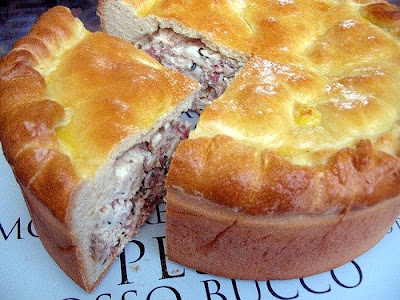Several years ago a to-be-left-unnamed food critic for a to be-left-unnamed weekly publication oood and ahhhed over the gumbo at a local restaurant (now long closed). The problem wasn’t that I’d eaten this gumbo and thought it awful (they had burnt the roux) but rather the assertion in his review that “real gumbo contains okra.” Thus began a back and forth posturing in print about who knew what he was talking about. To the delight and entertainment of my friends, this exchange was more than a little snarky and became known as The Gumbo Wars.
Now, I’ll be the first to admit that the origin of the word gumbo comes from the Bantu (Angolan) word (ki)ngombo, meaning okra but all gumbo does not contain okra. Okra is used as a thickener but so is filé, also called gumbo filé, a spice made from dried and ground

sassafras and thyme leaves. Rarely are the two used together in the same recipe, but many varieties contain neither. What all gumbo does have in common is a roux—flour browned in fat. Depending upon the type of gumbo, the roux can vary from the color of peanut butter to dark chocolate. This hearty more –stew-than-soup can and does contain just about anything—seafood, smoked sausage and ham, meat and game. Another common ingredient is what’s referred to as the Creole or Cajun trinity—chopped onions, green pepper and celery. A popular variation is called gumbo z’herbes (green gumbo) and traditionally served on Good Friday. Legend has it that you’ll make as many new friends as the number of different greens you use in your recipe. One thing that never goes in real gumbo is rice: it’s always served ladled over boiled rice

Gumbo is a staple along the Gulf Coast but prevalent throughout the South. Eating gumbo is popular all year long but especially during cold weather and in Louisiana a dish always served on Christmas Eve. African Americans, Native Americans, French and Spanish Creoles have added their influence to this meal in a pot.
Gumbo is slow food at its best. Around here, if you want a good bowl of the real thing you’ll have to make it yourself. Even at a restaurant in New Orleans finding good gumbo is not as easy as you might think. For a long time, it was something made and enjoyed at home so why order it when you went out? To be sure it might make the menu of a local diner or a venerable institution like
Galatoire’s or
Antoine’s. For a time, many of the newer, upscale restaurants looked upon it as too pedestrian. However, restaurateurs like Paul Prudhomme and Emeril Lagasse have helped make the dish more popular than ever. One of my favorite “new” gumbos is served at
Mr. B’s Bistro, run by a branch of the renowned Brennan family. It’s called Gumbo Ya Ya (their
recipe is on their web page)—“gumbo ya ya” is a Cajun expression that means everyone talking at once.
Anyone who knows me knows how much I like to cook, but I avoided making gumbo for a long time because it can be a very tedious process browning the roux. The procedure requires constant stirring and vigilance. If you burn the roux it will bitter and inedible and you have to start over. I’m not much for short cuts but a few years ago, reading
Gourmet magazine (January, 1997) I came across
how to make roux in the microwave. I was skeptical until I tried it—I’m skeptical about anything to do with the microwave—but it’s truly amazing! You really can teach old cooks new tricks.

Mr. B’s Gumbo Ya-Ya
Adapted from the recipe from B’s Bistro in New Orleans, my version serves 8 to 10 (the original recipe makes 24 cups). It also takes advantage of making the roux in the microwave.
1/3 cup vegetable oil (I use grapeseed or peanut oil)
½ cup bread flour
1 red bell peppers, chopped
1 green bell peppers, chopped
1 medium onions, chopped 1 celery stalk, chopped
8 cups rich chicken stock
8 cups water
1 tablespoons Creole seasoning
½ teaspoon ground black pepper
½ teaspoon dried hot red pepper flakes
½ teaspoon chili powder
½ teaspoon dried thyme
2 teaspoons chopped garlic
1 bay leave (preferably fresh)
2 teaspoons kosher salt
1 pound andouille sausage, cut into ¼-inch slices
1 whole roasted chicken breast, skinned, boned and coarsely chopped
Tabasco to taste
Boiled rice
Garnish:
Chopped green onions
In a 1-quart microwave-safe measuring cup blend together well the oil and bread flour. Microwave uncovered at high power for 2-minutes. Remove and stir thoroughly. Repeat this procedure twice. This may require some experimentation at first, depending on the power of your microwave. It’s important to thoroughly stir the flour mixture until it’s absolutely smooth each time before returning to the microwave. Continue to microwave at 1 minute intervals, stirring well in between intervals, until you have a dark mahogany brown roux.
Transfer the roux to a stock pot set over low heat. Add the chopped bell peppers and stir constantly for about 30 seconds. Add the chopped onions and celery and stir constantly for another 30 seconds or so until the vegetables have softened. Slowly add the stock and water to the roux and vegetables, stirring constantly to prevent lumps. Add the Creole seasoning, black pepper, red pepper flakes, thyme, garlic, bay leaf, kosher salt and andouille and bring to a boil.
Reduce heat and simmer the gumbo, uncovered, for 45 minutes, skimming off any fat and stirring occasionally. Cool the gumbo to room temperature. The gumbo may be made several hours or the day before, but cover and refrigerate after two hours. Right before serving, make the rice. Add the chicken to the gumbo and reheat. Adjust seasoning with Tabasco or other hot sauce. Serve over rice garnished with green onions and hot sauce on the side.















